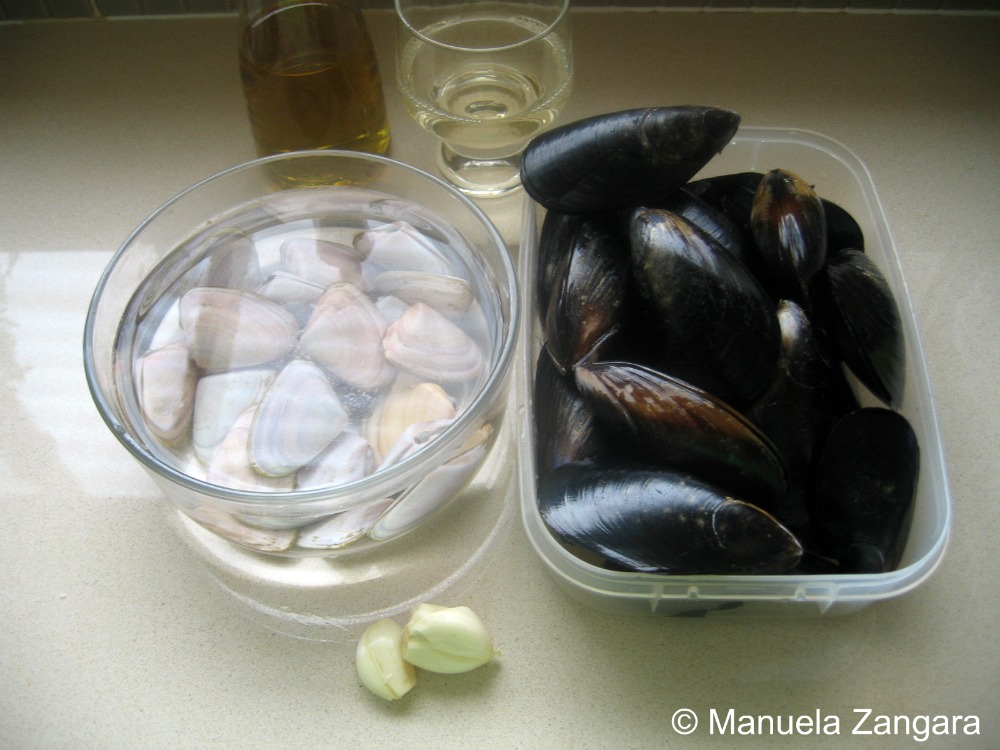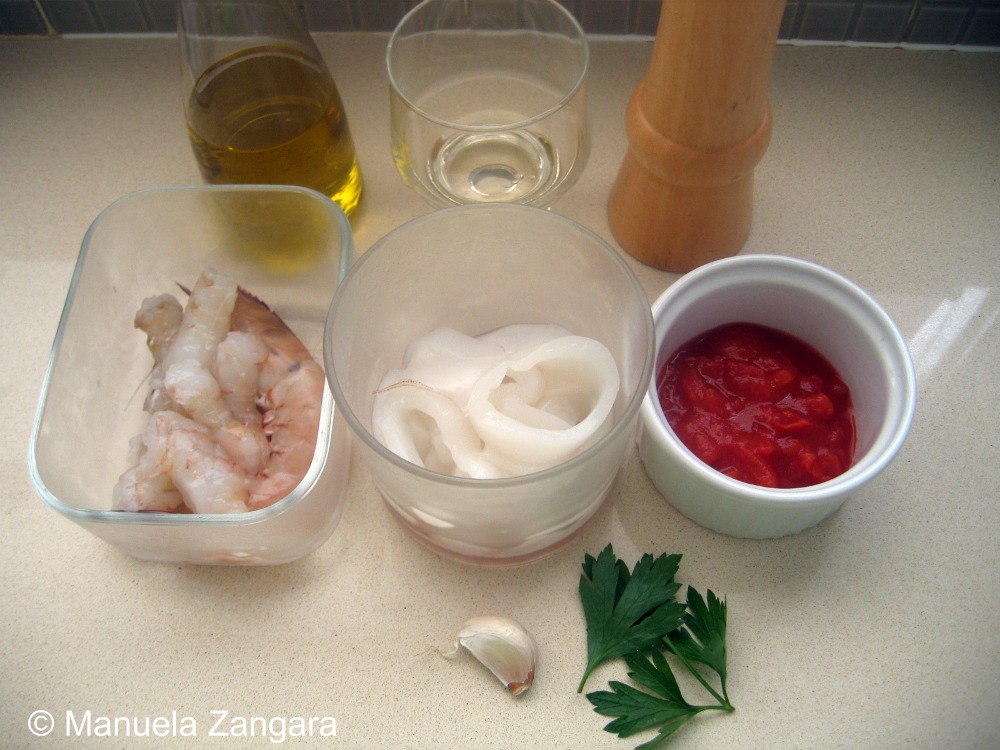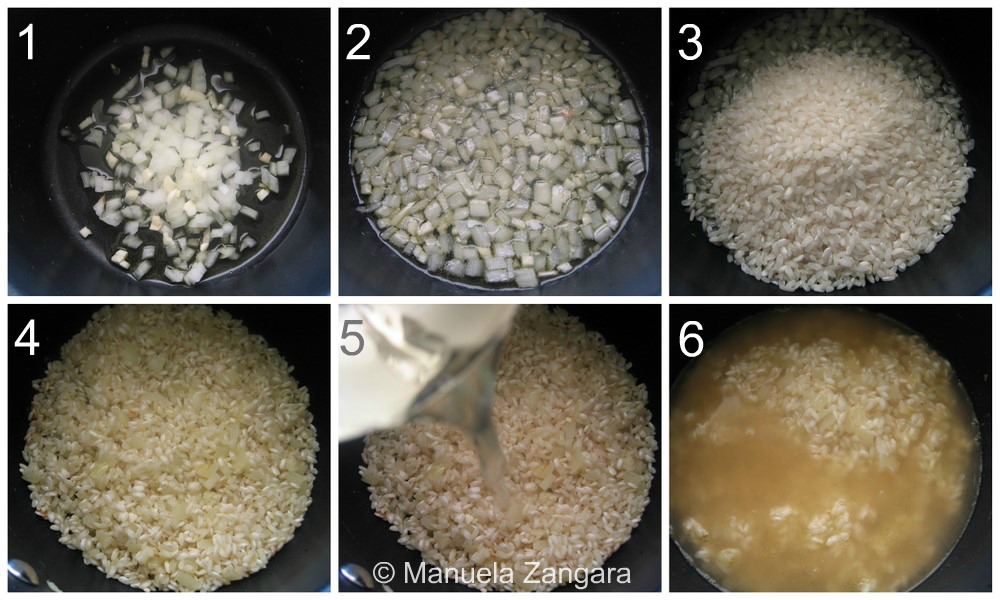Today I am going to share with you the guest post I wrote for Tina at Pinay Cooking Corner! Please, if you haven’t done it yet… stop by my friend Tina’s site to read my guest post and all of Tina’s fantastic recipes and say hi to her!!! 🙂
When my dear friend Tina asked me to write a guest post on Risotto alla Marinara for her beautiful site Pinay Cooking Corner, I couldn’t have been more thrilled. I have a soft spot for risotto, and it is the first dish I learnt how to cook completely on my own as a child. Making risotto is very easy, you just need to know a few simple rules and the great part is that the method is always the same: after you master the basic technique, you can make ANY kind of risotto you like. Making Risotto alla Marinara is no exception and even though it does require a bit of time and a few extra steps, it is no more complicated than any other risotto. “Alla Marinara” literally means “seaman style” and it is basically the same as “Alla pescatora” (“fisherman style”) and “Ai frutti di mare” (“with seafood”), so it is a seafood risotto and it is most commonly found in the coastal areas of Italy where fresh seafood is abundant. You could cook it with any combination of seafood (the ingredients vary slightly depending on “today’s fresh catch”), but I was lucky enough to find the most classic combo of ingredients at the fishmonger: prawns, calamari, mussels and vongole (or pippies/clams). Making this risotto with fresh seafood makes a huge difference, so I highly recommend it. I hope you enjoy it as much as my family and I did!
Ingredients (for 4 people)
For the mussels and vongole/pippies
25 big mussels
25-30 vongole or pippies
2 tbsp extra virgin olive oil
2 cloves of garlic, halved
60 ml – 2 oz. white wine
For the prawns and calamari
12 big prawns
2 calamari
1 clove of garlic, minced
3 or 4 tbsp diced tomatoes
50 ml – 1.7 oz. white wine
2 tsp parsley, chopped
Water
Salt to taste
For the risotto
320 gms – 11.3 oz. rice (Arborio, Carnaroli or Vialone nano)
½ onion, minced
1 clove of garlic, minced
2 tbsp extra virgin olive oil
100 ml – 3.4 oz. white wine
1 lt – 33.8 oz. broth (made with the prawn scraps and salt)
Juice of mussels and vongole
2 tsp parsley, chopped
Salt to taste
For the mussels and vongole/pippies
Clean the mussels under running water and keep the aside. Rinse the vongole/pippies and put them in a container filled with salty water. Keep them in the water for a few hours (even overnight). This will help any sand that is still inside the shells to come out.
Put all the mussels and vongole in a large pan. Add the garlic, extra virgin olive oil and wine and put the pan on the fire. Cover it and let it cook for a few minutes. You need to check every couple of minutes or so and remove all the shells that open as they are ready. If you overcook them, they will become chewy and hard. Keep cooking until all the shells open (discard the shells that do not open). This will take between 10 to 15 minutes. Remove the majority of the seafood from the shells, but keep a few in the shells to use as decoration. Filter the cooking juice and keep it aside. You will need this for the risotto.
For the prawns and calamari
Clean the calamari and cut them into rings (to do this, you can use your kitchen scissors). Clean the prawns (all but one that you will use to decorate the final dish – I cut mine in half as they were really big) and keep ALL the scraps (heads and shells) as you will use these to make a prawn broth for the risotto.
Put the minced garlic and extra virgin olive oil into a pot and sauté for a minute. The garlic does not have to burn or it will turn bitter. Add the diced tomatoes and cook on a slow fire for a couple of minutes.
Now add the calamari (1), stir and add the white wine (2). Cook off the alcohol, then add a couple of tablespoons of water and a pinch of salt and cook covered and on a low fire, until the calamari are tender. The time will depend on the calamari you are cooking. Mine took about 30 to 40 minutes. You may or may not need to add a little extra water to them. When the calamari are ready, add the full prawn and 2 teaspoons of chopped parsley and keep cooking for 5 minutes (3). Then add the cleaned prawns, stir and cook them for 1 minute (4). Do not overcook as they will keep cooking in the risotto and you do not want to make them chewy. Cover the pot and put the fire off. Keep it aside.
To make the prawn broth, put the prawn scraps into a pot, cover it with water and add some salt. Put this pot on the fire, bring it a boil and then let it simmer until it reduces of 1/3. When ready, filter it and keep it aside.
To make risotto, start by mixing the filtered juice from the mussels and vongole with the filtered prawn broth.
Add some water if the final mixture is not 1 liter. Put the broth on the fire and let it simmer. The broth has to be hot all the time while you are cooking risotto, so that the rice temperature does not drop when you add the broth to it.
Put the finely chopped onion, garlic and the 2 tablespoons of extra virgin olive oil in a pot (1) and let it cook on a slow fire, until the onion and garlic become soft and transparent (2). Add the rice (3), mix well and let it cook for 1 or 2 minutes, until it becomes translucent (4). Now pour in the white wine (5) and let the alcohol burn off by cooking on a high flame. Then add enough hot broth to cover the rice and turn the fire to medium-low (6).
Keep cooking, occasionally stirring the rice and adding hot broth little by little, until the rice is cooked. It is going to take approximately 18 to 20 minutes depending on the rice you are using.
After the first 12 minutes (1), add all the seafood (apart from the shells and the full prawn that you kept aside for decoration) (2-3), mix and keep cooking until the rice is ready. A couple of minutes before the rice is ready, add the chopped parsley (4), check for salt and season to your liking. Stir, put the fire off and cover it for 1 minute.
Make sure that your risotto is moist (or, as we say, all’onda – which literally means wavy) and not sticky. You can do that by adding 1 or 2 extra tbsp of hot broth if needed.
Decorate the final dish with some more chopped parsley, the full prawn and the mussels and pippies in their shells. Serve hot!
TIP: Whenever you cook risotto, do not wash the rice before cooking. The starch is needed for the risotto to become creamy.
THANK YOU so much Tina!!!

































calamari for 30-40 minutes?? I think you meant 3-4 minutes?????
You can either cook them very little, or very long to get them soft. It depends on the calamari.
How lovely! tweeted and buzzed 🙂
This looks absolutely heavenly! Love, love the stock made from the prawns. I’ve been meaning to make a risotto for a while now. This dish is all the encouragement I need. Thank you!
ah what have we here! Looks wondeful Manu, great presentaion. I d finish it all, just cant live without sea food and I need a change from rice and curry, so I am looking forward to cook your lovely risotto
How beautiful, how rich! *___*
This dish of seafood is over the top! What a huge bowl of flavor and textures! Great dish Tina!
Love it! Wishing you a happy Easter!
There is an advantage if you live in a sea side, this is my case, Lima is in the coast of Peru so it’s very easy for us to have fresh sea food. Everything that is made with sea food is for me, I just like it very much. Tomorrow is Holy Friday here and we cannot eat meat, so this a very delicious alternative.
This looks beautiful studded with all that gorgeous seafood. This would be the perfect Easter family dinner!
I love you. Come cook for me. Please?
Mmmm. I love risotto, and add mussels and shrimp and I will be the happiest person on earth. Delicious!
Once again, I would like to say thanks so much for the wonderful guest post, Manu! ♥♥♥
I adore seafood with rice or pasta! Soooo good. I also have a little surprise for you!
Fresh seafood in risotto! It should taste so divine! Looks really gorgeous!